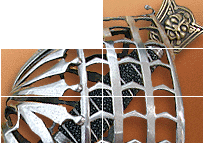| Author |
Message |
|
Gabriele Becattini
|
 Posted: Wed 23 Jul, 2008 12:54 am Post subject: french sword pattern Posted: Wed 23 Jul, 2008 12:54 am Post subject: french sword pattern |
 |
|
hello,
i would like to know if someone can post a list of the various french army pattern sword of the post napoleonic
period. thanks for help
|
|
  |
 |
Vincent Le Chevalier

|
 Posted: Wed 23 Jul, 2008 3:00 pm Post subject: Re: french sword pattern Posted: Wed 23 Jul, 2008 3:00 pm Post subject: Re: french sword pattern |
 |
|
Hi Gabriele,
| Gabriele Becattini wrote: | i would like to know if someone can post a list of the various french army pattern sword of the post napoleonic
period. thanks for help |
I have such a list in one of my books, I even have plates for each of the sword and saber listed... However the list in question is quite long (I count 45 weapons, sabers and swords). And using words I don't really know how to translate in proper English 
Perhaps you could narrow down your request a bit, it would be a less tedious work for me 
--
Vincent
Ensis Sub Caelo
|
|
   |
 |
|
Gabriele Becattini
|
 Posted: Fri 25 Jul, 2008 5:12 am Post subject: Posted: Fri 25 Jul, 2008 5:12 am Post subject: |
 |
|
Hi Vincent,
i was interested principally in having a short list ( but for sure if you have some pics they are welcome)
of infantry, cavalry and artillery officer, but if you have also enlisted man , sword pattern starting from the second empire period till the first world war. thank you very much for help.
gabriele
|
|
  |
 |
Vincent Le Chevalier

|
 Posted: Fri 25 Jul, 2008 5:32 am Post subject: Posted: Fri 25 Jul, 2008 5:32 am Post subject: |
 |
|
If you can read some French, maybe I can take pictures of the pages that give the list and post them here? Or maybe someone with more knowledge of the specific vocabulary would help us out...
--
Vincent
Ensis Sub Caelo
|
|
   |
 |
|
Gabriele Becattini
|
 Posted: Sat 26 Jul, 2008 3:04 pm Post subject: Posted: Sat 26 Jul, 2008 3:04 pm Post subject: |
 |
|
hi Vincent,
i can read french, so if you can post some images with comments it would be great, if not
i appreciated also a simple list.
Gabriel
|
|
  |
 |
Vincent Le Chevalier

|
 Posted: Mon 28 Jul, 2008 2:35 pm Post subject: Posted: Mon 28 Jul, 2008 2:35 pm Post subject: |
 |
|
Hi Gabriele,
Here are scans of the index of the plates I have. For the post Napoleonic period I think you'll be looking at plates 26 to 36. Let me know if there are specific plates you'd like to see in full, or if you have a problem with the language...
Regards,
 Attachment: 93.6 KB Attachment: 93.6 KB
First part [ Download ]
 Attachment: 119.47 KB Attachment: 119.47 KB
Second part [ Download ]
 Attachment: 114.45 KB Attachment: 114.45 KB
Third part [ Download ]
--
Vincent
Ensis Sub Caelo
|
|
   |
 |
|
Gabriele Becattini
|
 Posted: Tue 29 Jul, 2008 2:50 am Post subject: Posted: Tue 29 Jul, 2008 2:50 am Post subject: |
 |
|
Hi Vincent,
great work thanks a lot!
The list is perfect and easy to read. If you can please post some pics of the following patterns:
Marine officer model 1837
Infantry officer model 1845 and 1882
cavalry officer model 1882 and 1896
cavalry trooper model 1882 and 1896
thank you again
gabriele
|
|
  |
 |
Vincent Le Chevalier

|
 Posted: Tue 29 Jul, 2008 1:48 pm Post subject: Posted: Tue 29 Jul, 2008 1:48 pm Post subject: |
 |
|
Hello Gabriele,
So if I'm not mistaken you're interested in plates 28, 30, and 32. Here they are with a short summary of the description given in the book...
Plate 28:
3: Sabre d'officier subalterne et d'adjudant d'infanterie modèle 1845
The blade is 770mm long, slightly curved with a short false edge near the tip. I think the blade is hollow-ground.
4: Sabre d'officier supérieur d'infanterie modèle 1845
The hilt is more voluminous. The blade is 860mm long, straight, with a fuller and hollow-ground on either side. I can't really figure from either text or picture if the blade is double edged?
Plate 30:
1: Sabre des officiers d'infanterie modèle 1882
Straight blade, 830mm long, double edged.
2: Sabre de cavalerie modèle 1882
Straight, single-edged hollow-ground blade, comes in 3 lengths, 950mm, 925mm, 870mm.
3: Sabre de calvalerie de ligne modèle 1896, troupe
Straight hollow-ground blade with a flase edge near the tip, 950mm long. The drawing shows the guard that was meant to be more protective than the previous one, on both sides.
4: Sabre d'officier de cavalerie modèle 1896
Largely like the trooper's except for the more decorated hilt, and 3 different lengths of blade.
Apparently these cavalry sabers saw a very limited success...
Plate 32:
5: Sabre d'officier de marine modèle 1837
The blade is slightly curved, between 700mm and 800mm, with a false edge forming on the last third towards the tip.
Don't trust the pictures here for curvature of the blades, as you can see by the frame there has been distorsion as I'm probably shooting from too close.
In case you can find it, the book in question is Les armes blanches : sabres et épées, by Dominique Venner, published by Jacques Grancher in 1986. Unfortunately I think it is out of print now...
Hope this helps!
 Attachment: 91.45 KB Attachment: 91.45 KB
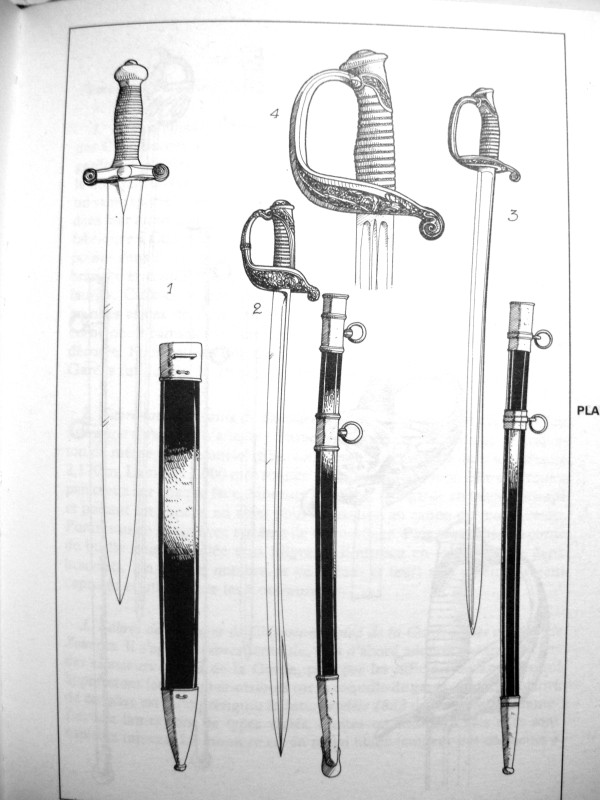
Plate 28
 Attachment: 93.1 KB Attachment: 93.1 KB
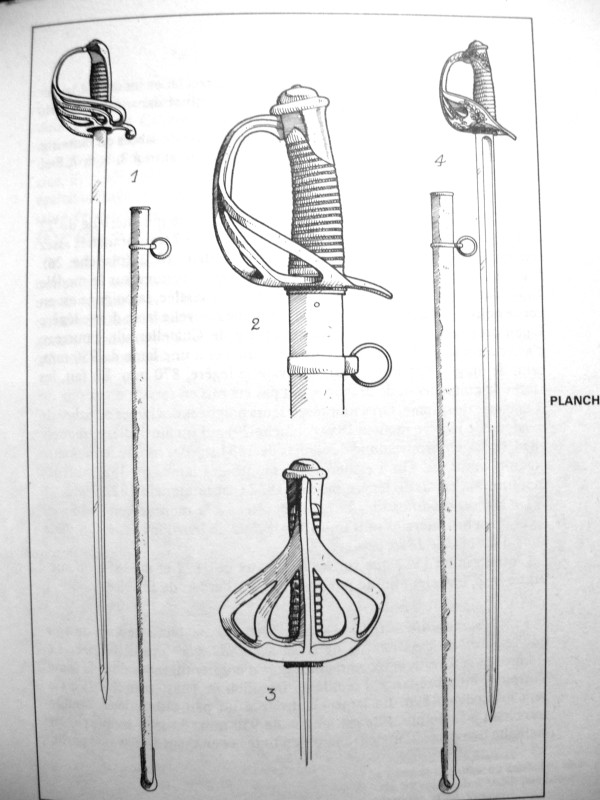
Plate 30
 Attachment: 101.75 KB Attachment: 101.75 KB
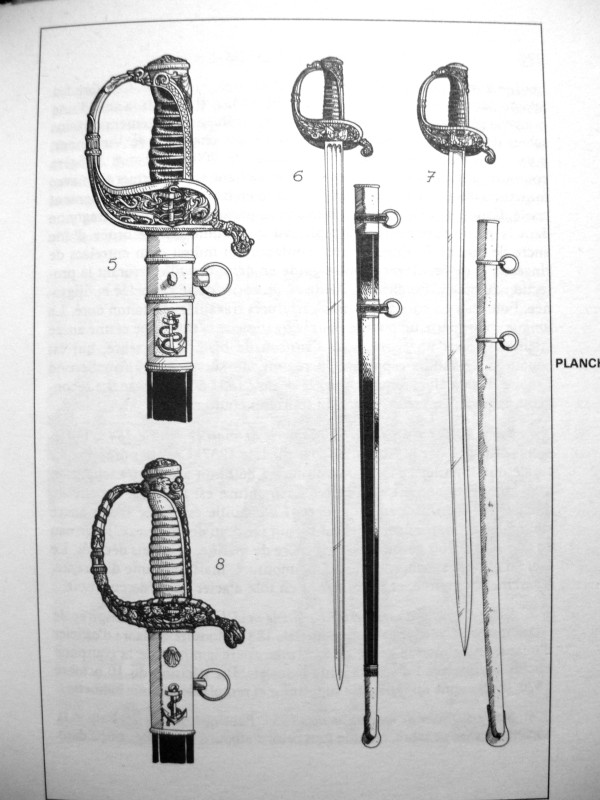
Plate 32
--
Vincent
Ensis Sub Caelo
|
|
   |
 |
Glen A Cleeton

|
 Posted: Tue 29 Jul, 2008 4:34 pm Post subject: Posted: Tue 29 Jul, 2008 4:34 pm Post subject: |
 |
|
Vincent,
Many thanks for posting these plates. I do agree with you that drawings should only be viewed as a rough draft, as i can see specifically with the 1882 infantry officer example (I have seen a couple of variations, single and double edges). As to the 1845 you wonder, or mention
| Quote: | 4: Sabre d'officier supérieur d'infanterie modèle 1845
The hilt is more voluminous. The blade is 860mm long, straight, with a fuller and hollow-ground on either side. I can't really figure from either text or picture if the blade is double edged? |
I am attaching a photo of one made in the early 20th century (not great but it is something). These are a double edged and double fullered blade, the center in the drawing being simply the medial ridge. A good many German and other European dagen use a similar multi-fullered blade. I have seen as many as four slim fullers. The infantry blade is virtually the same as what you see on plate 32 #6.
I would be extremely interested in seeing plate 24, of the epees. Thanks in advance if you can find the time. I stumble along ok with reading French. There are a couple listed of that plate that have me curious.
Cheers
GC
|
|
  |
 |
|
Gabriele Becattini
|
 Posted: Wed 30 Jul, 2008 1:38 pm Post subject: Posted: Wed 30 Jul, 2008 1:38 pm Post subject: |
 |
|
Very good pics Vincent, thank you for posting.
Do you know for how many years the 1845 infantry sword has remained on service ?
|
|
  |
 |
Vincent Le Chevalier

|
 Posted: Wed 30 Jul, 2008 4:15 pm Post subject: Posted: Wed 30 Jul, 2008 4:15 pm Post subject: |
 |
|
Hi Glen,
Thanks for your comments! I have to admit that these weapons and this time period are completely outside my main area of interest, so I just tried to sum up the book content as best as I could. In the case of the 1845 it's a bit strange, because the text really says two hollow-ground planes and only one fuller in between ("lame droite à deux pans creux de chaque côté, séparés par une gouttière"). On the drawing it seemed fairly clear to me that the thing in the middle wasn't a ridge because of the shadows... Maybe other blades existed for this weapon that the book does not mention?
Anyway, here is a picture of plate 24. The plate itself is not of a very high quality, as if badly printed. There are no further comments in the text, just what you can see in the index of plates. I hope it still helps...
Hi Gabriele,
The 1845 infantry sword has been used as late as 1885 apparently. There were changes made to the scabbard at this date, so they were still in used though gradually replaced by the 1882.
Regards,
 Attachment: 88.41 KB Attachment: 88.41 KB
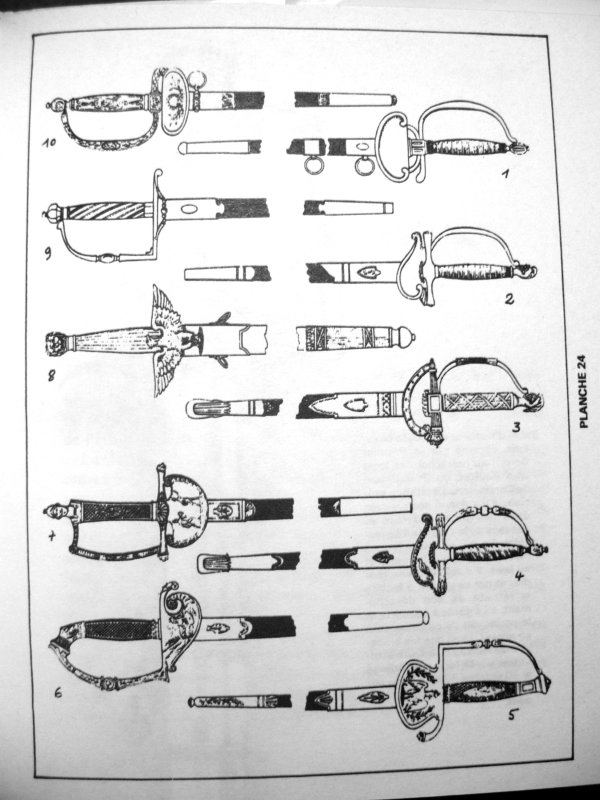
Plate 24
--
Vincent
Ensis Sub Caelo
|
|
   |
 |
Glen A Cleeton

|
 Posted: Wed 30 Jul, 2008 5:08 pm Post subject: Posted: Wed 30 Jul, 2008 5:08 pm Post subject: |
 |
|
Thanks much Vincent,
That plate puts a few to words I stumble with.
On the 1845s, it is entirely possible your read of the text and picture is correct. I'm sure there are other variations as well. Just when we think we have seen it all, something else appears. As mentioned, I have seen simlar blades withas many as four fullers. The endless variation of some genre and patterns is no less than overwhelming at times. You'd think by the 19th century, it would settle down but the numbers of swords produced and their variety in any given location was quite prodigous.
Cheers
GC
|
|
  |
 |
|
Rob O'Reilly
Location: Ottawa, Canada Joined: 07 Aug 2008
Posts: 2
|
 Posted: Thu 07 Aug, 2008 6:32 pm Post subject: Posted: Thu 07 Aug, 2008 6:32 pm Post subject: |
 |
|
| Vincent Le Chevalier wrote: | In the case of the 1845 it's a bit strange, because the text really says two hollow-ground planes and only one fuller in between ("lame droite à deux pans creux de chaque côté, séparés par une gouttière"). On the drawing it seemed fairly clear to me that the thing in the middle wasn't a ridge because of the shadows... Maybe other blades existed for this weapon that the book does not mention?
|
Greetings Vincent,
Your translation of the French text is correct, and period Modele 1845 for Senior Officers do have the triple fullered blade as you describe. To answer your other question, yes the blade is double edged to the point.
Attached are a few of pics of mine, dated 1846.
Rob
 Attachment: 95.86 KB Attachment: 95.86 KB
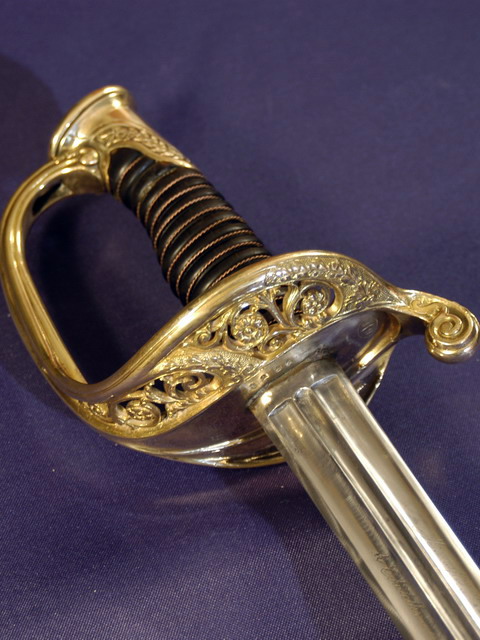
 Attachment: 141.02 KB Attachment: 141.02 KB
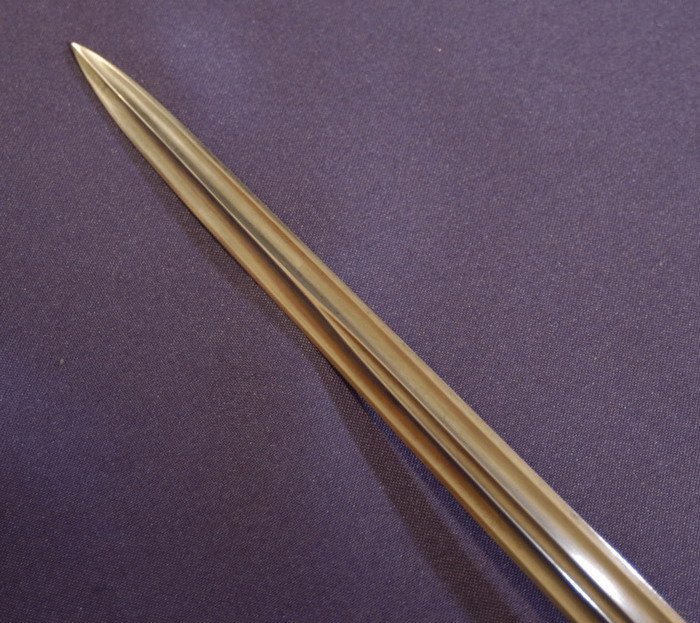
 Attachment: 70.83 KB Attachment: 70.83 KB
[ Download ]
Vir prudens non contra ventum mingit
|
|
  |
 |
|
Jonathan Hopkins
|
 Posted: Thu 07 Aug, 2008 7:07 pm Post subject: Posted: Thu 07 Aug, 2008 7:07 pm Post subject: |
 |
|
Rob,
That is a stunning sword and an incredible blade! Did the blade pattern vary at all throughout the lifetime of this model? Come to think of it, what WAS the lifespan of this model? This pattern could tempt me to stray from British swords... 
Jonathan
|
|
  |
 |
|
Rob O'Reilly
Location: Ottawa, Canada Joined: 07 Aug 2008
Posts: 2
|
 Posted: Sat 09 Aug, 2008 6:56 pm Post subject: Posted: Sat 09 Aug, 2008 6:56 pm Post subject: |
 |
|
Jonathan,
It is a very nice sword. This particular example surviving in remarkable condition. I picked it up on a visit to Paris, tucked in the corner of a store that sold antique toy soldiers.
The modele 1845 was officially replaced by the Model 1882 (sword 1 on plate 30 above), however the sword pattern was still in use (and manufactured) until well after WWI.
Rob
Vir prudens non contra ventum mingit
|
|
  |
 |
|
|
